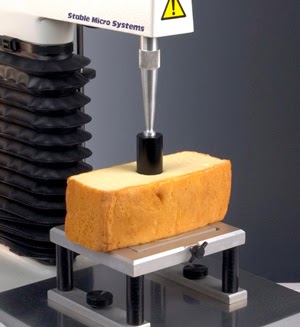 The American Institute of Baking (AIB) has a collection of procedures for testing the texture of common bakery products with a texture analyser.
The American Institute of Baking (AIB) has a collection of procedures for testing the texture of common bakery products with a texture analyser. Bakery products come in every imaginable type and shape, so meaningful textural comparisons must account for the different product geometries. The test procedures typically manage such differences in geometry by reducing the products’ size to a common denominator.
Generally, the objective of most of these tests is to measure the firmness and shelf life of a baked product; summaries of a few such methods are highlighted below.
 |
| Cylinder probe uncapped muffin test |
High profile textural characteristics of muffins are their firmness and ‘elasticity’. The standard AIB Muffin Firmness and Elasticity method measures initial firmness at two depths (6.25mm and 7mm), and then the residual firmness after an incremental 30 seconds of hold time, using a 18mm rounded edge probe. The residual force after 30 seconds holding time is then divided by the initial force at that depth to calculate percent ‘elasticity’ (often also called relaxation). This test is performed on samples which, for repeatability purposes, have their ‘crowns’ removed to display a flat surface for correct probe-to-product contact.
 |
| Knife blade muffin crown test |
 |
| Muffin elasticity graph |
Another concern, when using special ingredients to firm up a baked product, is whether the exterior crumb of the product is altered as a side effect of the treatment. To examine the firmness of the muffin crust, a knife blade can be used to cut through the top crowns that were removed from the muffins. The peak force of each curve can be used as a measure of the hardness of the crown, while the gradient of the initial part of the curve (usually between 5% and 30% of the maximum force) provides a measurement of the crust’s stiffness.
 |
| Cylinder probe test on cake |
The AIB sample preparation procedure for cake uses a template to provide two 1" wide slices from the centre of the cake which are then rested on their side for testing. A 1" diameter cylinder probe penetrates the crumb to 6mm in three different areas close to the centre of the crumb; the maximum force is recorded and used as an indication of firmness.
 |
| Cylinder probe bagel test |
According to the AIB standard procedure for bagels, samples are typically tested on days 1, 3 and 7 after baking. The bagels are sliced to 1" thick; then an 18mm diameter rounded edge probe is penetrated into the bagel to a depth of 6.2mm. The maximum force value is recorded and used as an indication of firmness. A doughnut, which is of very similar form, may be tested in the same way.
 |
| Bun/bagel test result graph |
In the standard AIB procedure for buns, samples of 17mm height are prepared by removal of the crust and crown (with the aid of a sample preparation template). With the inside crumb facing upward a 1" diameter cylinder probe is used to penetrate the bun to a depth of 5mm. As with bagels, the maximum force value is recorded and used as an indication of firmness.
This post illustrates just a small part of the capability of the TA.XTplus in the field of bakery testing. Use the links below to find out more.
The TA.XTplus texture analyser is part of a family of texture analysis instruments and equipment from Stable Micro Systems. An extensive portfolio of specialist attachments is available to measure and analyse the textural properties of a huge range of food products. Our technical experts can also custom design instrument fixtures according to individual specifications.
|





No comments:
Post a Comment